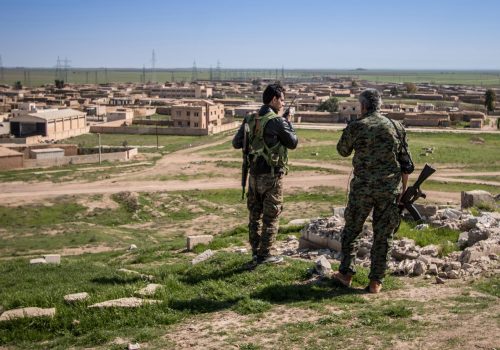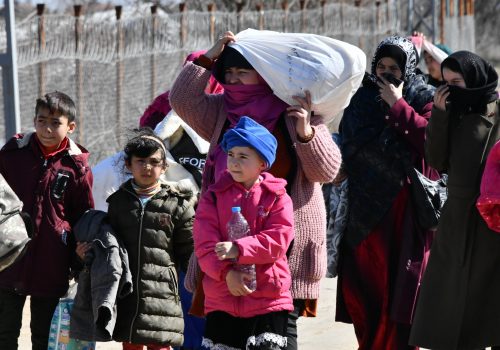Syria has a water crisis. And it’s not going away.
In May 2021, the flow of the Euphrates River in northeast Syria fell to an all-time low, causing the worst drought since 1953. Months later, in September 2021, Hammoud al-Hamadin, an engineer at the Tishreen dam, located southeast of Mambij in Aleppo province, warned of a historic and terrifying decline in its water level. Since the Euphrates is the primary water source for agriculture, domestic consumption, and electricity production in northern and eastern Syria, the crisis has affected all three vital sectors.
The dramatic drop in water storage of the Tabqa, Tishreen, and Baath dams on the Euphrates threatens agricultural production on more than 475,000 acres (two hundred thousand hectares) of irrigated land, according to our research. Local farmers have lost 80 percent of their harvest and, in Hasakeh province, the breadbasket of the country, more than 90 percent. Farmers are also forced to sell their livestock due to lack of fodder—given the scarcity of grass—or their inability to buy it at the 200 percent cost increase. A new wave of migration in Syria from rural areas to cities, which adds to the hundreds of thousands of people who already abandoned their farms as a consequence of droughts in 2006, 2008, and 2010, further swell slums that have burgeoned around Syria’s larger cities, including the capital, Damascus.
In addition to agricultural production, potable water provision is also under threat. Drinking water is rationed all over the country, forcing people to rely on unsafe water sources or choose expensive private water trucking services. The lack of sanitized water has alarming consequences for public health, compounded further due to the coronavirus pandemic.
According to our research, the three Euphrates dams provide around 70 percent of the electricity consumed in Syria. Currently, only four of the eight turbines at the Tabqa dam are working due to a water shortage. As a result of the water shortage since May 2021, there have been drastic effects on the Syrian populace. For example, some neighborhoods in the provincial town of Hasakeh in the northeast and the suburbs of Damascus receive only two hours of electricity per day. Even parts of central Damascus experience power outages of up to eighteen hours a day.
Syria’s hydropolitics
The current water crisis wasn’t entirely unexpected. Profound changes to Syria’s hydrology have been taking place for decades due to mismanagement, climate change, economic growth, intensified water use, and heightened competition for water across international boundaries.
The first decade of the 2000s saw a sharp rise in electricity demand due to increased population and economic development, a reduction in rainfall, and rising temperatures. By 2010, devastating droughts in northern and eastern Syria forced some three hundred thousand rural families to migrate to Aleppo, Damascus, and Deir ez-Zor provinces. As a consequence of these problems, agricultural production—usually a quarter of Syria’s gross domestic product—declined by a third in 2010.
Intensive irrigation of high-yield crops, inefficient irrigation techniques, and illegal well drilling have all contributed to the water crisis. Moreover, high surface evaporation rates from the three reservoirs—337 square miles (873 square kilometers) surface area—have caused a loss of water that is now estimated at 77.7 billion cubic feet (2.2 billion cubic meters), as per our research.
Overexploitation and depletion of freshwater resources, water contamination by mercury and lead, increased soil salinity, wildfires and dust storms, soil deterioration, and progressive desertification have all resulted in extensive environmental degradation.
When the Syrian uprising began in 2011, water was an important factor in sparking the revolt because the drought exacerbated the existing socio-economic distress. Since the conflict began, it has proved catastrophic for Syrian water resources; damaged infrastructure left entire regions without irrigation, drinking water, and hydro-electric power, rendering them increasingly vulnerable to seismic activity. Moreover, the fragmentation of Syria under competing factions allowed each to weaponize water for its own military and political ends. For example, the Islamic State of Iraq and al-Sham (ISIS) used control of water resources as a military tactic to break resistance, source of revenue, and political tool to consolidate its “state” by providing services to its territories.
The expansion of Kurdish forces in northern Syria brought the three biggest Syrian dams under the control of the Kurdish-led Autonomous Administration of North and East Syria. This prompted the intervention of Turkey and its de facto occupation of parts of the border region, while the Syrian government recovered control of the southern part of the Euphrates basin. Ever since, Syrian and Turkish officials and Northeastern Syria region officials have continued to exchange accusations of disruption to water services.
Nevertheless, the conflict has brought occasional and unexpected cooperation between formal enemies in managing water services. For example, in 2013, ISIS allowed Syrian government engineers to man dams and water facilities so that water would flow to Iraq. There have been reports of similar arrangements between Damascus and Kurdish authorities. Such practices reflect tactical maneuvering by belligerent parties. Unfortunately, none of the rebel authorities have devised plans to reform and modernize their water systems. Instead, they continue to subsidize fuel for groundwater pumps.
Reforming the Syrian water sector
The continuous desiccation of major water resources, such as the Khabour and Jaghjagh rivers, and the fact that Syrians are still pumping annually around 1.2 billion cubic feet (thirty-four million cubic meters) of groundwater, according to our research, is well beyond the amount that can be replenished, and show that the Syrian government has lost control of the country’s water resources. Moreover, various reports denouncing mismanagement by Syrian authorities at various levels and calling for urgent repairs of thirty-one dams to avert major failures—such as the collapse of the Zeyzoun Dam in 2002—have been ignored.
Effective water management requires reforming existing agricultural policies, weak institutions, and corrupt bureaucracies. Nevertheless, even the latest irrigation policy reforms, developed by the Syrian Economic Task Force set up in 2013, didn’t create mechanisms to enforce the 140 water laws written during the last century. The lack of coordination between the relevant institutions—the Ministries of Water Resources, Agriculture, Local Administration, and ad hoc committees—hamper effective policymaking and implementation.
Irrigation practices started to change after farmers were granted interest-free loans to introduce modern irrigation and water conservation techniques. Moreover, a sharp increase in the price of electricity made pumping water more expensive, which encouraged water conservation. Nonetheless, significant obstacles persist.
A crucial obstacle is the upstream diversion of the Euphrates water. Turkey, Syria’s neighbor in the north, has the great geographical advantage of receiving nearly all the rain and snowfall that forms and replenishes the river. Turkey’s 31,788 square miles (82,330 square kilometers) catchment basin contributes to 89 percent of the river’s annual flow. The river flows 283 miles (455 kilometers) through Turkey before flowing through Syria and then through Iraq to the Gulf. The geographical advantage of Turkey is augmented by its economic and military might.
In 1974, Turkey began the construction of its Great Anatolian Project, which will eventually include twenty-two dams and nineteen hydroelectric plants along the Tigris and Euphrates rivers to irrigate 4.2 million acres (1.7 million hectares) of land in Turkey’s Harran region. A Protocol on Economic Cooperation signed in 1987 granted Turkey 50 percent of the Euphrates water. Of the remaining 50 percent, which would continue through Syria and Iraq, Syria was to receive an average of 17,657 cubic feet per second (500 cubic meters per second).
The combined results of Turkish hydro-politics and climate change, which affects rainfall in Turkey as well, have been a roughly 40 percent reduction in water flow into Syria. Currently, the water flow is only around 7,062 cubic feet per second (200 cubic meters per second)—less than half agreed in the Protocol. This is a major contributing cause to the unprecedented drought, which, in turn, has led to a decline in electricity production and potable water supplies, as well as to water pollution in northern Syria. The concentration of pollutants in the water discharged by the dams, when combined with temperature rise, algae proliferation, and evaporation is likely to destroy northern Syria’s ecosystem.
The combination of climate change, domestic mismanagement, competition, and regional conflict has brought the water issue to the top of the local and regional actor’s political agenda. When the Euphrates River became a political border between warring factions, water scarcity turned into a key regional security issue. The persistent lack of cooperation among the Euphrates riparian states—Iraq, Syria, and Turkey—confronts the world with a new potential conflict in the Middle East and North Africa, which is already devastated by wars and the disastrous effects of climate change. Inside Syria, only a thorough ongoing reform of water policies that addresses social and geopolitical inequalities would help drain a quagmire that breeds social unrest.
Dr. Aurora Sottimano is a lecturer at the University of International Studies in Rome, nonresident Senior Fellow of the Centre for Syrian Studies, St. Andrews University, and visiting researcher at the Centre for International Studies, Lisbon University Institute in Portugal. She specializes in the politics and regional relations of the Middle East, with a focus on Syria. Follow her on Twitter: @masott3.
Dr. Nabil Samman is an engineering economist who specializes in international water resources, with a focus on the Middle East. He is a former senior researcher at the Center for Water Research and Documentation in Syria, and a consultant to the Arab Water Center of the Arab League.
Further reading
Thu, Feb 10, 2022
A perpetrator of Syrian crimes against humanity went free in France. Here’s why it shouldn’t happen again
MENASource By Michel Duclos
If the scope for changing the course of events in Syria is limited, it’s honorable to take a stand against the abominable crimes of the Bashar al-Assad regime. It would be a great pity for France to be seen as a safe haven for Assad’s accomplices.
Fri, Sep 3, 2021
Afghanistan demonstrates why it’s time for a clear Syria policy, starting with northeast Syria
MENASource By Reem Salahi
If Afghanistan is to teach us anything, the Biden administration should not ignore Syria by having a non-existent policy. The longer the Syrian conflict continues, the more intractable and unmanageable it becomes.
Tue, May 5, 2020
Aid groups desperately look for other options to combat coronavirus
MENASource By Borzou Daragahi
The pandemic has prompted organizations to reconfigure the way they provide aid.
Image: Residents fill containers with water in a rebel-controlled area of Aleppo, Syria July 24, 2015. Picture taken July 24, 2015. REUTERS/Abdalrhman Ismail


